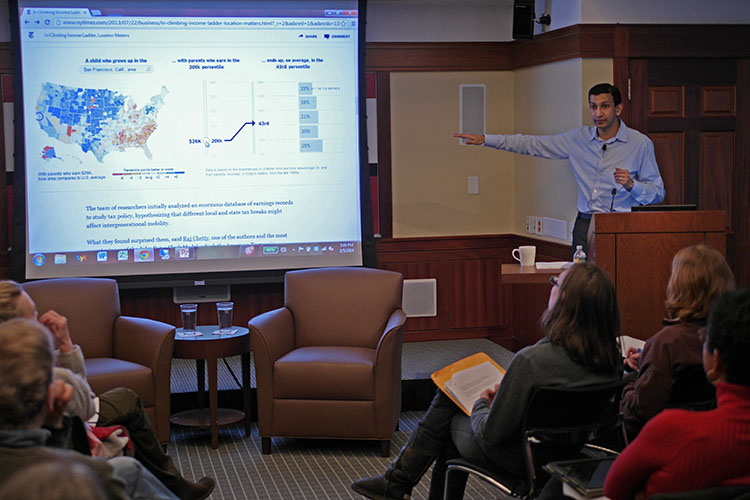
Harvard economics professor Raj Chetty shows a data visualization model that The New York Times created from research he and his colleagues did on income mobility in the United States. Photo by Jonathan Seitz
Is the United States a land of opportunity where hard work can lead to success no matter where you start in life? According to Raj Chetty, Bloomberg Professor of Economics at Harvard, it largely depends on where you live.
Chetty came to the Nieman Foundation on February 5 to discuss his latest research examining economic inequality in the United States. He encouraged journalists to study the data he and his fellow researchers collected, and to use it to drive investigations of their own communities. Articles with data visuals, like a New York Times article featuring a map allowing readers to track upward mobility in communities across the country, often generate the most discussion, he said.
Raj Chetty praised The New York Times for using his team's research to create an interactive map of income mobility, which helped make the data more understandable
In “Where Is The Land of Opportunity? The Geography Of Intergenerational Mobility In the United States,” Chetty and his research team analyzed data to measure income mobility across the country and to determine what factors correlate with such mobility.
Their report, published in January, finds that the odds of moving up or down the income ladder in the U.S. have remained stable since the 1970s. These odds have never been very high, especially compared with other developed nations. Their findings, combined with earlier studies, suggest that upward mobility did not change in the last half of the 20th century. This finding, which contradicts what members of both political parties have been saying, prompted President Obama’s speechwriters to consult with Chetty about language used in his State of the Union address.
While income mobility is stable, Chetty and his team found that income inequality has increased substantially. A child born in the 1990s has the same chance of climbing the income ladder as a child born in the 1970s, but the rungs are now farther apart.
Yet the odds of climbing the ladder are far from even across the country. Using income records for 40 million Americans, Chetty and his team measured economic mobility in 741 commuting zones across the country. In some places, like San Jose or Salt Lake City, upward mobility is relatively high, with children born in the lowest 20% of incomes nationally having more than a 10 percent chance of rising to the top 20% of incomes as adults. In other parts of the country, like Atlanta and Charlotte, the chance of making this jump is less than 5 percent. What makes places like San Jose or Salt Lake City different from Atlanta or Charlotte? Areas with greater income mobility tend to share five characteristics: less segregation, less income inequality, better schools, greater social capital, and more stable families.
Raj Chetty's research found that racially segregated cities, like Atlanta, have lower rates of upward mobility—for residents of all races—compared to more racially integrated cities, like Sacramento
While these five factors are correlated with mobility, Chetty warns that these factors should not be interpreted as causes. For example, areas with lower rates of income mobility are strongly correlated with the number of single parents living in that area. Does this mean that marriage leads to upward mobility, as some commenters suggest? Chetty said that children living in areas with a large proportion of single parents have worse outcomes, even if their own parents are married. “So you know from that that it is not per se about your own parents’ marital status, it’s something about family structure in your community which is predicting children’s outcomes” he said.
Areas with a large number of African Americans, like Atlanta, tend to have relatively lower rates of upward mobility. Yet white Americans living in the same areas also have poorer outcomes. “It’s not that there are differences in upward mobility by race,” Chetty said, “but that there are differences in upward mobility by place that are correlated with racial shares.”
Chetty and his team are examining how growing up in an area with higher or lower rates of upward income mobility affects children. They are looking at individuals who spent part of their childhood in an area with low income mobility before moving to an area with higher income mobility. Their preliminary findings suggest that for every year a child spends living in an area with better upward mobility, their chance of moving up the income ladder as adults increases. “Every extra year you spend in the better area, it’s like a dosage effect. Your outcome seems to grow commensurately,” said Chetty.
Chetty hopes that research into the factors behind upward mobility will ultimately lead to public policy that helps disadvantaged children move ahead.
An early finding from Raj Chetty's latest research is that children who move from a city with lower rates of income mobility to one with greater income mobility experience an increase in their own upward mobility
Watch the Complete Seminar


